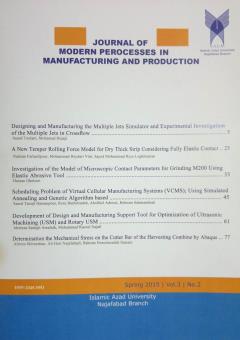-
-
List of Articles
-
Open Access Article
1 - Evaluation of the Cryogenic Effect on Friction Stir Processed AA7075/Si Matrix Nanocomposites
Navid Molla Ramezani Behnam Davoodi -
Open Access Article
2 - Study of the Impact of Supply Chain Sustainability Dimensions on Sustainable Competitive Advantage with the Mediating Role of Production Flexibility and Strategic Flexibility (Case Study: Dairy Industry of Fars Province)
Shahab Heidari Belgheis Bavarsad Majid Nili Ahmad Abadi Saber Mola Alizade Zavardehi -
Open Access Article
3 - Evaluating the Potential of Polycaprolactone/Heparinized Nano Fluoro Hydroxyapatite Composite Scaffolds for Advancing Bone Tissue Engineering: A Comprehensive Analysis of Biodegradability and Water Absorption
Nila Haghani Nahid Hasanzadeh Nemati Mohammad Taghi Khorasani Shahin Bonakdar -
Open Access Article
4 - Experimental Investigation of the Effect of Using Tools with Tapered Pins in Friction Stir Welding (FSW) of AA6061-T6 Aluminum Alloy
Saleh Al Khatour Maziar Mahdipour Jalilian Mahdi Karami Khorramabadi -
Open Access Article
5 - Effect of Welding Processing Parameters on FSW of Aerospace Grade Aluminum Alloys
Erfan Khosravian -
Open Access Article
6 - Investigating the Effect of T6 Heat Treatment on Mechanical Properties of 7075 Al Alloy
Mohsen Emami Vahid Hasan Nasab
-
The rights to this website are owned by the Raimag Press Management System.
Copyright © 2021-2025







